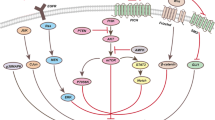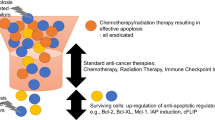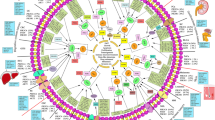Abstract
A novel strategy has been suggested to enhance rapamycin-based cancer therapy through combining mammalian target of rapamycin (mTOR)-inhibitors with an inhibitor of the phosphatydilinositol 3-kinase PI3K/Akt or mitogen-activated protein kinase/extracellular signal-regulated kinase (MAPK/ERK) pathway. However, recent study demonstrated the potentiating effect of rapamycin on all-trans-retinoic acid (ATRA)-mediated differentiation of acute myelogenous leukemia (AML) cells, prompting us to investigate the effects of longitudinal inhibition of PI3K/Akt/mTOR signaling pathway on both proliferation and differentiative capacity of AML. In NB4, HL-60, U937 and K562 cell lines, rapamycin exerted minimal antiproliferative effects, and combining PI3K inhibitor LY 294002 and rapamycin inhibited proliferation more than LY 294002 alone. Rapamycin potentiated differentiation of ATRA-treated NB4 cells, but the combination of rapamycin and LY 294002 inhibited the expression of CD11b in both ATRA- and phorbol myristate acetate (PMA)-stimulated cells more than PI3K inhibitor alone. These results demonstrate that, although the combination of PI3K inhibitor and rapamycin is more effective in inhibiting proliferation of AML, the concomitant inhibition of PI3K and mTOR by LY 294002 and rapamycin has more inhibitory effects on ATRA-mediated differentiation than the presence of PI3K-inhibitor alone, and diminishes positive effects of rapamycin on leukemia cell differentiation.






Similar content being viewed by others
Abbreviations
- PI3K:
-
Phosphatydilinositol 3-kinase
- mTOR:
-
Mammalian target of rapamycin
- AML:
-
Acute myelogenous leukemia
- MAPK/ERK:
-
Mitogen-activated protein kinase/extracellular signal-regulated kinase
- APL:
-
Acute promyelocytic leukemia
- ATRA:
-
All-trans-retinoic acid
- PMA:
-
Phorbol myristate acetate
References
Xu Q, Simpson SE, Scialla TJ et al (2003) Survival of acute myeloid leukemia cells requires PI3 kinase activation. Blood 102:972–980
Follo MY, Mongiorgi S, Bosi C et al (2007) The Akt/mammalian target of rapamycin signal transduction pathway is activated in high-risk myelodysplastic syndromes and influences cell survival and proliferation. Cancer Res 67:4287–4294
LoPiccolo J, Blumenthal GM, Bernstein WB et al (2008) Targeting the PI3K/Akt/mTOR pathway: effective combinations and clinical considerations. Drug Resist Updat 11:32–50
Papa V, Tazzari PL, Chiarini F et al (2008) Proapoptotic activity and chemosensitizing effect of the novel Akt inhibitor perifosine in acute myelogenous leukemia cells. Leukemia 22:147–160
Tabellini G, Tazzari PL, Bortul R et al (2004) Novel 2′-substituted, 3′-deoxy-phosphatidyl-myo-inositol analogues reduce drug resistance in human leukaemia cell lines with an activated phosphoinositide 3-kinase/Akt pathway. Br J Haematol 126:574–582
Richardson P, Wolf JL, Jakubowiak A et al (2009) Perifosine in combination with bortezomib and dexamethasone extends progression-free survival and overall survival in relapsed/refractory multiple myeloma patients previously treated with bortezombib: updated phase I/II Trial Results. Blood (ASH Ann Meeting Abstracts). 114:1869
Altman JK, Platanias LC (2008) Exploiting the mammalian target of rapamycin pathway in hematologic malignancies. Curr Opin Hematol 15:88–94
Bhaskar PT, Hay N (2007) The two TORCs and Akt. Dev Cell 12:487–502
Récher C, Beyne-Rauzy O, Demur C et al (2005) Antileukemic activity of rapamycin in acute myeloid leukemia. Blood 105:2527–2534
Nishioka C, Ikezoe T, Yang J et al (2008) Blockade of mTOR signaling potentiates the ability of histone deacetylase inhibitor to induce growth arrest and differentiation of acute myelogenous leukemia cells. Leukemia 22:2159–2168
Rizzieri DA, Feldman E, Dipersio JF et al (2008) A phase 2 clinical trial of deforolimus (AP23573, MK-8669), a novel mammalian target of rapamycin inhibitor, in patients with relapsed or refractory hematologic malignancies. Clin Cancer Res 14:2756–2762
Yee KW, Zeng Z, Konopleva M et al (2006) Phase I/II study of the mammalian target of rapamycin inhibitor everolimus (RAD001) in patients with relapsed or refractory hematologic malignancies. Clin Cancer Res 12:5165–5173
Kharas MG, Janes MR, Scarfone VM et al (2008) Ablation of PI3K blocks BCR-ABL leukemogenesis in mice, and a dual PI3K/mTOR inhibitor prevents expansion of human BCR-ABL + leukemia cells. J Clin Invest 118:3038–3050
Sun SY, Rosenberg LM, Wang X et al (2005) Activation of Akt and eIF4E survival pathways by rapamycin-mediated mammalian target of rapamycin inhibition. Cancer Res 65:7052–7058
Tamburini J, Chapuis N, Bardet V et al (2008) Mammalian target of rapamycin (mTOR) inhibition activates phosphatidylinositol 3-kinase/Akt by up-regulating insulin-like growth factor-1 receptor signaling in acute myeloid leukemia: rationale for therapeutic inhibition of both pathways. Blood 111:379–382
Carracedo A, Ma L, Teruya-Feldstein J et al (2008) Inhibition of mTORC1 leads to MAPK pathway activation through a PI3K-dependent feedback loop in human cancer. J Clin Invest 118:3065–3074
Kinkade CW, Castillo-Martin M, Puzio-Kuter A et al (2008) Targeting AKT/mTOR and ERK MAPK signaling inhibits hormone-refractory prostate cancer in a preclinical mouse model. J Clin Invest 118:3051–3064
Wang ZY, Chen Z (2008) Acute promyelocytic leukemia: from highly fatal to highly curable. Blood 111:2505–2515
Petrie K, Zelent A, Waxman S (2009) Differentiation therapy of acute myeloid leukemia: past, present and future. Curr Opin Hematol 16:84–91
Matkovic K, Brugnoli F, Bertagnoli V et al (2006) The role of the nuclear Akt activation and Akt inhibitors in all-trans-retinoic acid-differentiated HL-60 cells. Leukemia 20:941–951
Nishioka C, Ikezoe T, Yang J et al (2009) Inhibition of mammalian target of rapamycin signaling potentiates the effects of all-trans retinoic acid to induce growth arrest and differentiation of human acute myelogenous leukemia cells. Int J Cancer 125:1710–1720
Matkovic K, Lukinovic-Skudar V, Banfic H et al (2009) The activity of extracellular signal-regulated kinase is required during G2/M phase before metaphase-anaphase transition in synchronized leukemia cell lines. Int J Hematol 89:159–166
Breslin EM, White PC, Shore AM et al (2005) LY294002 and rapamycin co-operate to inhibit T-cell proliferation. Br J Pharmacol 144:791–800
Ikezoe T, Nishioka C, Bandobashi K et al (2007) Longitudinal inhibition of PI3K/Akt/mTOR signaling by LY294002 and rapamycin induces growth arrest of adult T-cell leukemia cells. Leuk Res 31:673–682
Scholl S, Bondeva T, Liu Y et al (2008) Additive effects of PI3-kinase and MAPK activities on NB4 cell granulocyte differentiation: potential role of phosphatidylinositol 3-kinase gamma. J Cancer Res Clin Oncol 134:861–872
Yen A, Roberson MS, Varvayanis S et al (1998) Retinoic acid induced mitogen-activated protein (MAP)/extracellular signal-regulated kinase (ERK) kinase-dependent MAP kinase activation needed to elicit HL-60 cell differentiation and growth arrest. Cancer Res 58:3163–3172
Das D, Pintucci G, Stern A (2000) MAPK-dependent expression of p21WAF and p27kip1 in PMA-induced differentiation of HL-60 cells. FEBS Lett 472:50–52
Miranda MB, McGuire TF, Johnson DE (2002) Importance of MEK-1/-2 signaling in monocytic and granulocytic differentiation of myeloid cell lines. Leukemia 16:683–692
Crabbe T, Welham MJ, Ward SG (2007) The PI3K inhibitor arsenal: choose your weapon! Trends Biochem Sci 32:450–456
Chiarini F, Falà F, Tazzari PL et al (2009) Dual inhibition of class IA phosphatidylinositol 3-kinase and mammalian target of rapamycin as a new therapeutic option for T-cell acute lymphoblastic leukemia. Cancer Res 69:3520–3528
Park S, Chapuis N, Bardet V et al (2008) PI-103, a dual inhibitor of Class IA phosphatidylinositide 3-kinase and mTOR, has antileukemic activity in AML. Leukemia 22:1698–1706
Bertagnolo V, Neri LM, Marchisio M et al (1999) Phosphoinositide 3-kinase activity is essential for all-trans-retinoic acid-induced granulocytic differentiation of HL-60 cells. Cancer Res 59:542–546
Lal L, Li Y, Smith J et al (2005) Activation of the p70 S6 kinase by all-trans-retinoic acid in acute promyelocytic leukemia cells. Blood 105:1669–1677
Hay N (2005) The Akt-mTOR tango and its relevance to cancer. Cancer Cell 8:179–183
Park SJ, Kang SY, Kim NS et al (2002) Phosphatidylinositol 3-kinase regulates PMA-induced differentiation and superoxide production in HL-60 cells. Immunopharmacol Immunotoxicol 24:211–226
Acknowledgements
We thank Ms Dunja Tankovic for valuable technical help and assistance. This work was supported by the Ministry of Science, Education and Sport of the Republic of Croatia, grants No. 108-1081347-1448 (to D. V.) and 108-1081347-0173 (to H. B.).
Author information
Authors and Affiliations
Corresponding author
Rights and permissions
About this article
Cite this article
Mise, J., Dembitz, V., Banfic, H. et al. Combined Inhibition of PI3K and mTOR Exerts Synergistic Antiproliferative Effect, but Diminishes Differentiative Properties of Rapamycin in Acute Myeloid Leukemia Cells. Pathol. Oncol. Res. 17, 645–656 (2011). https://doi.org/10.1007/s12253-011-9365-z
Received:
Accepted:
Published:
Issue Date:
DOI: https://doi.org/10.1007/s12253-011-9365-z




